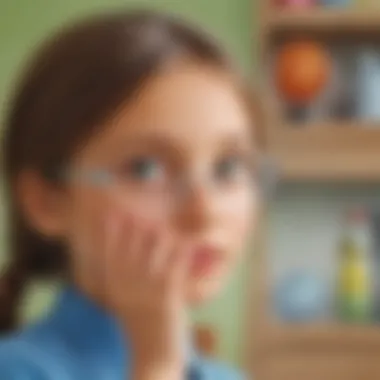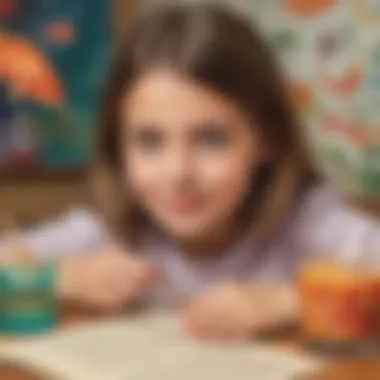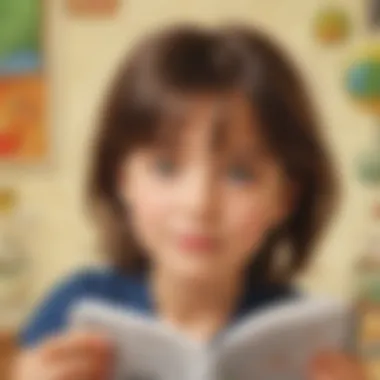Engaging Activities for Kids: Exciting Lesson on the Five Senses


Interactive Learning Games
- Engage kids in interactive learning games that enhance their understanding of the five senses. These games are designed to be both fun and educational for children aged 3-12.
- Description of top educational games: Explore popular educational games that focus on sensory experiences, encouraging children to learn about sight, hearing, taste, touch, and smell in an engaging way.
- Benefits of playing educational games for kids' cognitive development: Playing these games helps children improve cognitive skills such as problem-solving, memory retention, and critical thinking.
- Game Reviews: In-depth reviews of selected educational games provide insights into gameplay, learning objectives, and how they support sensory learning.
- Comparison of gameplay and learning outcomes: Compare different educational games to understand how each game contributes to sensory development.
Creative DIY Projects
Step-by-Step Guides
- Engage children in hands-on activities with detailed step-by-step guides for creative DIY projects. These projects are designed to stimulate creativity and promote sensory exploration.
- Benefits of hands-on activities for children's cognitive and motor skills: By participating in DIY projects, children enhance their cognitive abilities and improve motor skills through tactile experiences.
Craft Ideas
- Introduce children to creative craft ideas using everyday household items, encouraging them to express themselves artistically and explore various sensory materials.
- Importance of artistic expression in children's development: Artistic activities play a crucial role in children's cognitive and emotional development, fostering creativity and self-expression.
Introduction
The human experience is intricately woven with the five senses, serving as our gateway to the world around us. In this article, we delve into the captivating realm of exploring the senses through an engaging and interactive lesson plan designed specifically for children aged 3-12. The significance of understanding the five senses from a young age cannot be overstated, as it lays the foundation for children to comprehend and appreciate the complexities of the world they inhabit. By immersing kids in experiential learning activities centered on sight, hearing, taste, touch, and smell, this lesson plan aims to spark curiosity, enhance cognitive development, and foster a deeper connection with their environment.
Overview of the Lesson Plan
The lesson plan outlined in this article is a meticulously crafted journey that takes young learners on a voyage of sensory exploration. Each section is strategically designed to resonate with children's innate curiosity and provide them with hands-on experiences that stimulate all five senses. Through a series of interactive activities, kids will not only engage with their senses but also gain a holistic understanding of how each sense contributes to their perception of the world. From creating vision boards to embarking on culinary adventures, the lesson plan offers a diverse range of activities that cater to different learning styles and preferences.
Importance of Teaching the Five Senses
Teaching the five senses is a fundamental aspect of early childhood education with far-reaching implications for children's overall development. By integrating sensory education into the curriculum, educators play a pivotal role in nurturing children's cognitive abilities, emotional intelligence, and perceptual skills. Understanding the five senses equips kids with essential tools to navigate their surroundings, communicate effectively, and make sense of the world. Moreover, sensory exploration ignites a sense of wonder and discovery in children, fostering a lifelong love for learning and a deep respect for the intricacies of the human experience.
Understanding Sight
Activities for Exploring Sight
Creating a Vision Board
Delving deeper into the realm of sight exploration, the activity of Creating a Vision Board stands out as a dynamic and innovative approach to engaging children in visual storytelling. By encouraging kids to curate a collage of images, words, and symbols that resonate with them, this activity sparks creativity and self-expression, nurturing their visualization skills and artistic flair. The key characteristic of Creating a Vision Board lies in its ability to blend imagination with reality, allowing children to manifest their dreams and aspirations visually. This hands-on activity not only enhances visual literacy but also promotes goal setting and self-reflection, making it a valuable tool for personal growth and development in the context of this article.


Color Scavenger Hunt
Another engaging activity tailored to amplify the understanding of sight is the Color Scavenger Hunt. This interactive game prompts children to identify and collect objects based on specific colors, honing their color recognition, discrimination, and visual acuity. The key characteristic of this activity is its ability to make learning about colors immersive and experiential, transforming a traditional lesson into an exciting adventure. By associating colors with real-world objects, children not only reinforce their understanding of hues but also cultivate observational skills and attention to detail. The Color Scavenger Hunt enriches the learning experience by fostering curiosity and exploration, turning the acquisition of knowledge into a joyful endeavor that aligns seamlessly with the educational goals of this article.
Significance of Sight in Daily Life
In the hustle and bustle of daily routines, the significance of sight often goes unnoticed, yet its impact on our lives is profound and far-reaching. This section aims to illuminate the pivotal role of vision in our everyday experiences, from appreciating the beauty of nature to engaging in artistic pursuits and navigating the world with ease and confidence. By shedding light on the importance of sight, children are encouraged to value their visual sense as a precious gift that enriches their interactions with the world and shapes their perception of reality. Through a blend of educational insights and real-life examples, this section underscores how sight enhances quality of life, sparks creativity, and fosters meaningful connections, reinforcing the fundamental role of vision in shaping our understanding of the world.
Engaging with Hearing
Interactive Hearing Activities
Sound Bingo
Sound Bingo is a captivating auditory game that not only entertains children but also sharpens their listening abilities. This activity involves listening to various sounds and matching them to corresponding images or words on a bingo card. Sound Bingo reinforces auditory memory, sound identification, and concentration skills in an enjoyable and educational manner. Its interactive nature engages kids in active listening, promoting cognitive development and sound awareness.
Musical Chairs
Musical Chairs is a classic game that stimulates children's auditory senses through music and movement. This activity enhances listening skills, rhythm recognition, and coordination as kids listen attentively to the music and respond by moving to different chairs. Musical Chairs encourages active participation, social interaction, and group engagement, making it a popular choice for enhancing the sense of hearing in the lesson plan. Its dynamic and interactive features promote sensory integration and auditory processing skills among children, fostering a holistic approach to sensory exploration.
The Wonders of Hearing
The Wonders of Hearing illuminate the vast capabilities of the auditory sense and its profound impact on children's daily experiences. Hearing allows individuals to connect with the world through sound, language, music, and environmental cues. In the context of this lesson plan, understanding the wonders of hearing cultivates empathy, sound appreciation, and active listening skills in children. By exploring the intricate nuances of sound perception and interpretation, kids develop a deeper understanding of the auditory sense's role in communication, emotion, and memory formation. The interactive exercises focusing on the wonders of hearing provide a multisensory experience that enriches children's cognitive and emotional development.
Exploring the Sense of Taste
In this section, we delve into the significant role of taste exploration in the interactive lesson plan for children aged 3-12. Understanding taste is crucial as it allows youngsters to not only appreciate different flavors but also develop a more holistic sensory experience. Through taste exploration, kids can enhance their palate, learn about food preferences, and even expand their cultural awareness through trying various cuisines.
Exploring the sense of taste is essential in cultivating children's sensory perception. By engaging in taste-related activities, kids can sharpen their ability to identify flavors, textures, and aromas, thereby enriching their overall sensory awareness. Additionally, encouraging taste exploration fosters a sense of curiosity and adventurousness in children when it comes to trying new foods.
Specific elements to consider in exploring the sense of taste include ensuring a safe environment for taste-testing experiments, considering any dietary restrictions or allergies of the children involved, and incorporating a variety of flavors and food items to provide a well-rounded tasting experience. By focusing on taste exploration, this article aims to enhance children's sensory development and promote a healthy relationship with food.
Taste Testing Experiment


Sweet vs. Sour Challenge
The Sweet vs. Sour Challenge is a key component of the taste testing experiment in this lesson plan. This activity aims to highlight the contrast between two fundamental taste profiles—sweetness and sourness. By juxtaposing these flavors, children can not only discern the difference between the two but also appreciate how various foods fall along this spectrum.
The main characteristic of the Sweet vs. Sour Challenge lies in its ability to engage children's taste buds and stimulate their sense of taste effectively. This activity is a popular choice for this article as it offers a straightforward yet impactful way to demonstrate taste differences. One of the key advantages of the Sweet vs. Sour Challenge is its versatility, allowing for the use of a wide range of food items to illustrate the concept of sweet and sour flavors.
Moreover, the unique feature of the Sweet vs. Sour Challenge is its interactive nature, encouraging active participation from children and facilitating discussions about personal taste preferences. While this activity is generally well-received, it is essential to be mindful of any potential dislikes or sensitivities to certain flavors among the participants.
Blindfolded Taste Test
Another integral part of the taste testing experiment is the Blindfolded Taste Test, designed to heighten children's sensory awareness without the visual component. This activity challenges kids to rely solely on their sense of taste, focusing on flavor recognition and textural differences.
The Blindfolded Taste Test is valuable in contributing to the overall goal of expanding children's sensory perception. By blocking out visual stimuli, kids are forced to concentrate solely on taste, leading to a deeper appreciation of flavors and food textures. This activity serves as a beneficial choice for this article as it encourages children to engage all their senses, particularly honing in on taste through the elimination of sight.
A unique feature of the Blindfolded Taste Test is its ability to promote sensory exploration in a more focused manner, fostering concentration and mindfulness during the tasting process. However, it is essential to consider any apprehensions or discomfort some children may have with blindfolded activities, ensuring that participation is voluntary and comfortable for all involved.
Discovering the Sense of Touch
Texture Exploration Activities
Sensory Bin Experience
The Sensory Bin Experience is a hands-on activity that allows children to engage and explore different textures through a tactile sensory play medium. This activity stimulates sensory perception, fine motor skills, and creativity in children, making it an integral component of the lesson plan. The key characteristic of the Sensory Bin Experience lies in its ability to offer a multi-sensory experience, combining touch with visual and sometimes auditory stimuli. The tactile richness of materials within the sensory bin provides children with a diverse range of textures to explore, encouraging sensory processing and cognitive development. The Sensory Bin Experience is a popular choice for this article due to its versatility and effectiveness in engaging children of varying ages and sensory preferences. While the advantages of the Sensory Bin Experience are plentiful in promoting sensory exploration and imaginative play, some considerations may include the need for supervision to ensure safe and appropriate exploration.
Texture Collage Creation
Texture Collage Creation is a creative activity that promotes tactile exploration and artistic expression among children. This hands-on craft allows kids to experiment with different textures, combining them to create visually stimulating collages. The key characteristic of Texture Collage Creation is its focus on integrating tactile elements into visual art, fostering sensory integration and fine motor skills. This activity is a beneficial choice for this lesson plan as it encourages children to not only explore textures but also to articulate their sensory experiences through art. The unique feature of Texture Collage Creation is its capacity to blend sensory exploration with artistic creativity, providing children with a platform to express their tactile perceptions. While Texture Collage Creation offers numerous advantages in fostering artistic abilities and sensory awareness, considerations may involve selecting age-appropriate materials to ensure a safe and engaging experience for the children.
Importance of the Sense of Touch
Exploring the importance of the Sense of Touch is paramount in understanding how tactile experiences contribute to children's overall sensory development. The sense of touch plays a significant role in children's cognitive, emotional, and social growth. Through tactile exploration, children not only gather information about the physical properties of objects but also develop an awareness of textures, temperatures, and pressure variations in their environment. Understanding the importance of touch enhances children's capacity to make connections between physical sensations and their surroundings. By integrating touch into learning experiences, children can improve their fine motor skills, sensory processing abilities, and emotional well-being.
Unveiling the Sense of Smell


In this section of the comprehensive interactive lesson plan focusing on exploring the five senses for children aged 3-12, we delve into the intriguing world of the sense of smell. The sense of smell, also known as olfaction, plays a crucial role in how we perceive the world around us. It is essential to highlight the significance of uncovering the mysteries of scent perception to provide a well-rounded understanding of sensory experiences. Through engaging activities that stimulate the sense of smell, children can enhance their cognitive development and sensory awareness.
Aromatherapy Playtime
Scented Playdough Making
Scented Playdough Making is a captivating activity that not only appeals to a child's creativity but also enhances their olfactory senses. By incorporating different scents into the playdough-making process, children are exposed to various smells, aiding in scent recognition and differentiation. The key characteristic of Scented Playdough Making lies in its ability to evoke sensory engagement, promoting relaxation and concentration among children. This activity is a popular choice for this article as it contributes to the holistic exploration of the sense of smell, providing a hands-on experience for children to connect scents with emotions and memories. The unique feature of Scented Playdough Making is its versatility, enabling children to experiment with different scents and textures, fostering sensory exploration and creativity. While there are no significant disadvantages to this activity, it is essential to ensure that the scents used are child-friendly and non-irritating to avoid any sensitivities.
Guess the Scent Game
The Guess the Scent Game adds an element of mystery and fun to the exploration of the sense of smell. By challenging children to identify various scents blindfolded, this activity sharpens their olfactory skills and memory retention. The key characteristic of the Guess the Scent Game is its ability to enhance children's scent recognition and association, making learning about smells interactive and enjoyable. This game is a beneficial choice for this article as it encourages children to rely on their sense of smell, boosting sensory awareness and perception. The unique feature of the Guess the Scent Game is its ability to stimulate cognitive functions related to memory, as scents are closely linked to emotional memories. While there are no direct disadvantages to this game, ensuring the safety of the scents used and supervising the activity is essential for a positive and educational experience.
The Power of Scents in Memory
The Power of Scents in Memory highlights the profound impact that smells can have on triggering memories and emotions. The olfactory system is closely linked to the limbic system, the area of the brain responsible for emotions and memory formation. Exploring scents and their association with memories can provide children with a powerful tool for retaining information and connecting with past experiences. By integrating scents into learning environments, educators can enhance memory retention and create multisensory learning experiences for students. This section emphasizes the importance of incorporating scents into educational settings to leverage the power of olfactory memory in enhancing learning outcomes and emotional connections.
Conclusion
In this article, the exploration of the five senses through an interactive lesson plan for kids is not just a mere educational activity but a transformational journey fostering a deep connection with the world around us. The conclusion serves as a pivotal point in solidifying the young learners' grasp of their sensory experiences. By reflecting on the key takeaways from each sense – sight, hearing, taste, touch, and smell – children can synthesize their newfound knowledge into a coherent understanding of how their senses shape their perception and interaction with their environment.
Moreover, the conclusion provides a platform for children to comprehend the interconnectedness of the senses, highlighting how each sensory input complements and enriches the others to create a holistic sensory experience. It reinforces the notion that honing one's senses not only enhances one's cognitive development but also cultivates a profound appreciation for the intricacies of the world.
Through this article, children are encouraged to approach their daily experiences with heightened awareness and curiosity, enabling them to engage with the world in a more meaningful and immersive manner. By embracing the richness of their sensory perceptions, kids can embark on a lifelong journey of exploration, creativity, and experiential learning, shaping them into individuals who savor every moment with a keen sense of wonder and appreciation for the boundless possibilities that the senses offer.
Recap of the Five Senses Learning Journey
As we traverse through the five senses learning journey in this interactive lesson plan, children have delved into a realm of sensory discovery and self-awareness that transcends the boundaries of traditional education. The recap serves as a poignant reminder of the multifaceted nature of human perception and the transformative power of sensory experiences in shaping our understanding of the world.
Each sense explored – sight, hearing, taste, touch, and smell – has unraveled a tapestry of sensations, emotions, and insights that have broadened the children's horizons and deepened their connection to the world around them. From the vibrant hues of a rainbow captured through sight to the melodious symphony of sounds echoing in their ears, each sensory encounter has left an indelible impression on their minds and hearts.
The recap not only consolidates the knowledge gained from each sense but also highlights the interconnectedness of the sensory systems, emphasizing how the fusion of sensory inputs contributes to a holistic sensory experience that is greater than the sum of its parts. By revisiting the pivotal moments of sensory exploration, children can internalize the significance of their sensory perceptions and integrate them into their everyday lives, fostering a level of sensory mindfulness that transcends passive observation.
Encouragement for Continued Exploration
As children embark on the final leg of their sensory learning journey, the encouragement for continued exploration serves as a beacon of inspiration, urging them to carry forward the spirit of curiosity, wonder, and discovery instilled throughout this interactive lesson plan. It is a call to arms for young learners to embrace their sensory capabilities as tools for exploration, creativity, and self-expression, propelling them towards new horizons of experiential learning and personal growth.
Beyond the confines of this lesson plan, the encouragement for continued exploration empowers children to seek out sensory experiences in every facet of their lives, from the everyday textures they touch to the tantalizing flavors they taste. It prompts them to look beyond the surface of things and delve deeper into the rich tapestry of sensory stimuli that surround them, fostering a lifelong habit of mindful observation and appreciation for the wonders of the senses.
By encouraging children to continue exploring their senses with zest and zeal, we equip them with a powerful tool for self-discovery and intellectual development, nurturing a generation of inquisitive minds who approach the world with open eyes, ears, mouths, hands, and noses, ready to unlock the treasures of sensory perception that await them at every turn.















